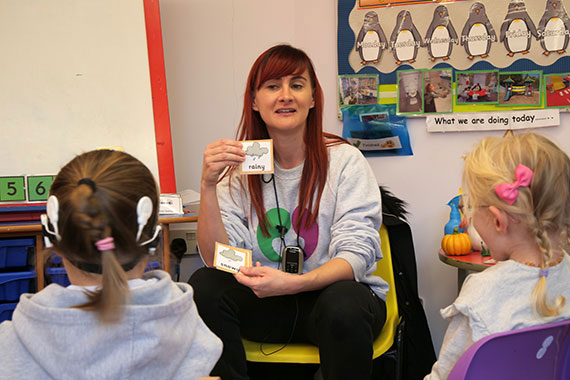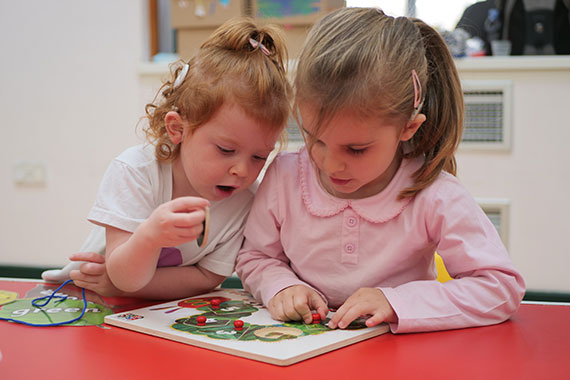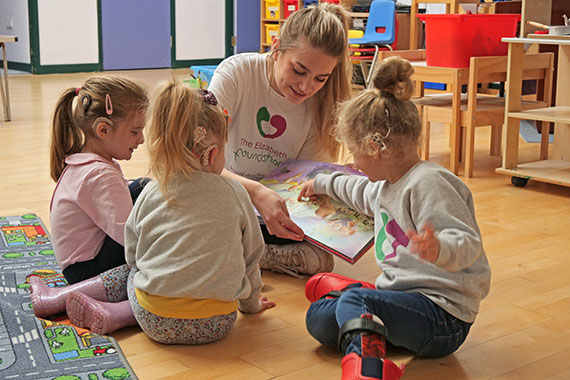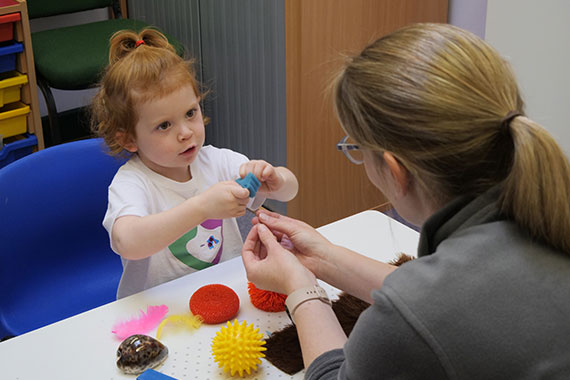Foundations for communication
Tips, advice and guidance from The Elizabeth Foundation to help young deaf children develop their listening and talking skills.
Starting school
How to help your preschool deaf child make a smooth transition into primary school
Starting school is the next exciting step in your preschool deaf child’s learning journey. Throughout your child’s life you will have made many important decisions on his or her behalf. Choosing a first school is the next step. This is an important transitional time for any child, but for your deaf child there are some additional factors to consider. In this article, we will help you to identify some of these extra things you might want to think about. In particular, we will:
- explore what to consider when choosing the school that will best suit your child’s needs
- discuss the types of support that might benefit your child’s transition to primary school
- identify what you can do to help equip your child to thrive in this new environment
This is a new and exciting time for your child and we hope that this information gives you some good ideas to support his or her journey onto school.
Identifying a suitable school for your child
There are many factors to consider when selecting a suitable school for any preschool child. However, for deaf children, there are some additional factors that you need to think about, so it’s a good idea to begin your research early. This will allow more time for you to gather information, talk to other parents, visit schools and discuss with your team of professionals before it comes to making any final decisions.
When the time comes, you will want to feel confident that you are giving your child the best possible chance to succeed at school. Your child’s first school should offer a learning environment that will maximise his/her full potential whilst fostering confidence and encouraging independence.
Keep an open mind
You know your child better than anyone else. However, try to keep an open mind as you are gathering information. You need to see the schools and meet the teaching teams before you can be sure of the right setting for your child.
Listen to what your supporting professionals have to say – they will have considerable experience and knowledge about local options. They may raise issues you hadn’t thought of before. Talk to parents with children at the schools you are visiting. The more detailed the picture you have, the easier it will be for you to make your decision.
Think about your child’s mode of communication
You should consider the choices you have made so far regarding the mode of communication you have chosen for your child. This will influence your choice of school and the sort of support you feel your child might need within that setting.
What are your local options?
Provision for deaf children in primary schools can differ greatly from area to area and you need to understand what your Local Authority offers. In addition to mainstream primary schools there may be mainstream schools with specialist provision for deaf children (often referred to as HI Units or Resourced Provisions). Or perhaps you are interested in a specialist school for deaf children or a small private school. Make sure you are aware of all that is available in your area. Your supporting professionals should be able to identify some suitable local options.
Take time to visit potential schools
Try to visit as many different types of school as possible – even if you don’t think they are suitable for your child. It will broaden your knowledge of how provision differs from one school to the next and will help you to prioritise what is important for you and your child.
Prepare for your school visits
Write a list of what you want to know and take it with you. It will make comparisons between schools easier and ensure you don’t forget anything. Make sure you see the whole school – remember, your child will probably spend time in most rooms!
And make sure you meet the key staff, including the Head Teacher and the Special Educational Needs Coordinator (SENCo). The SENCo will be responsible for ensuring your child receives the right support. They will also liaise with visiting professionals, coordinate meetings and communicate with you. It is important that you feel able to work closely with them. Pay attention to the questions they ask you. Searching questions mean they have thought about what might be involved in educating a deaf child and this is a good sign.
Balancing family needs
Your choice of education for your deaf child has to work for the whole family. The educational setting must be right for your child, but if it is a long distance away and adds too much stress to the logistics you need to be sure the advantages outweigh the disadvantages. If you have other hearing children, is it important that all your children go to the same school? This needs to be considered when making decisions around schools.
Getting the right support for your child in school
The type and level of support your child will need will depend on the type of school you choose, your child’s chosen mode of communication, and how well developed their listening, speech, signing, social and communication skills are.
At the very least, it is likely you are going to want your Teacher of the Deaf to visit. Other support might involve a Speech and Language Therapist, one-to-one support in the classroom from a Learning Support Assistant (LSA), signing support via a Communication Support Worker, technology such as a radio aid system and a soundfield system – the list goes on.
Once you are clear on the school and what support you would like in place for your child, there is a good chance you are going to need to go through the official system to get their needs formally assessed and agree levels of support.
There is a variety of support available in the classroom to aid your child’s learning. It is important to speak to your local team about the type of support you would like for your child in the classroom. Support can include:
- Pre-teaching of vocabulary.
- Finding a quiet place to review vocabulary.
- Emotional literacy support assistance (ELSA).
- Addressing classroom acoustics.
- Understanding of your child’s deafness and his/her hearing technology.
If your child has an Education, Health and Care Plan (an EHCP), it will also outline the support he or she needs.
This process requires you, and all the various professionals currently helping your child, to provide reports for your Local Authority (LA) detailing your child’s needs and explaining what additional support you all think he/she will need at school.
Your Teacher of the Deaf and chosen school can help guide you through this process. Again, this process can take time and is another reason not to leave things too late.
Consider the learning environment and ethos
Think about what information you need to know to make your decision and don’t be afraid to ask for it! Perhaps you might like to have a better idea of how your child performs when background noise is present. Certainly, the acoustics of the different schools will be an important part of your decision-making and knowing your child’s individual capabilities is important. Your Audiologist and Teacher of the Deaf should be able to assess this, and schools should be able to provide information on acoustics in their classrooms.
It is also important to consider the general ethos of the school. How welcoming is the Headteacher? How willing is the school to make adaptations and to receive training? How interested are the Headteacher and the Special Educational Needs Coordinator (SENCo) in learning about deafness and what your child will need to access the curriculum?
It’s your choice
Your child’s education is critical to their future and finding the right setting might feel a little daunting. However, if you start early, gather information and engage the help of the professionals supporting your child, the process will go much more smoothly. But above all, remember that having gathered all the information, and listened to what others have to say, you then need to make a choice based on your child’s individual needs and those of your family.
What can I do to prepare my deaf child for school?
There are plenty of ways you can support your child at home to give them a head start at their new “big school”.
Preparing your child for transition to school
Once you have decided on the school, there is a lot you can do in partnership with their team to help prepare your child for the move up to ‘big’ school:
- Contact the SENCo and work together. Most schools will organise transition visits so that you child can get familiar with the classroom and meet his/her teacher.
- Ask the SENCo to make an Experience Book for your child, including photographs of the key areas of the school, pictures of his/her teacher and any other staff members who will be involved with supporting your child (due to child protection issues, it is unlikely they will let you have pictures of the other children).
- There are things you can do at home as well: Look at the experience book together and talk about the people and the places. Try and spend time going over familiar games, books, fairy tales and songs that you child might encounter in their first term at school – again the SENCo can give ideas for these.
- Ask for information about any work the school will be covering in the first few weeks (e.g. books they might read, topics they might cover) and see if you can help prepare your child by going over key vocabulary and familiarising him/her with the stories and related information.
Communication skills
Your child’s listening and communication skills are the foundation for his/her learning at primary school.
The resources and videos on our Parent Education webpage provide further information about speech and language development for young deaf children, with videos about:
- an introduction to speech and language for young deaf children
- using a technique known as OWLing to develop speech and language skills
- ways to “build” language for young deaf children
- going on a speech sound safari to introduce your child to new speech sounds
The lessons in the Let’s Listen and Talk Preschool Programme provide information, advice and practical activities to help you develop your child’s listening, talking and communication skills ready for starting school.
Academic skills – literacy and numeracy
Literacy and numeracy are key elements of the national curriculum for key stage 1 at primary school.
- You can view and download the national curriculum in England for key stage 1 at primary school from the www.gov.uk website.
We have produced a range of resources to help you prepare your child’s literacy and numeracy skills before the start school:
- On our Parent Education webpage, you can watch a presentation about what to expect in terms of numeracy in your child’s Early Years Reception Class, and how to prepare your deaf child prior to starting school.
- Our Parent Education webpage also provides a range of literacy resources, including ways to promote imaginative play, using reading to promote literacy and how to help your child learn new words.
- Our Let’s Listen and Talk Preschool Programme includes information, advice and practical activities to help your preschool child develop their literacy and numeracy skills.
Independence / self-help skills:
- Getting dressed – Every morning, lay out your child’s clothes for the day for them to put on themselves. To begin with, this will take time but allowing your child the time to do it for themselves will speed this process up eventually. To encourage your child, you could also use a timer and a rewarding sticker when they complete the task. This is an important skill for your child to learn, as they will be expected to independently change into and out of their PE kits regularly at school.
- Finding and putting on/taking off coats – In a busy school cloakroom, your child needs to be able to locate their own coat, take it off the peg and put it on independently. To practise this skill, when going out of the house allow your child to put on their coat by themselves and then, when ready, teach them how to do up any zip/buttons, encouraging them to then do this for themselves.
- Putting on and taking off shoes – When going outside, allow time for your child to have a go at putting on their own shoes. To begin with Velcro fastening shoes are ideal until your child has learnt to tie shoelaces. If your child is struggling to put the correct shoe on the correct foot, you could cut a big sticker in half and place on the inside of each shoe – teach your child to match the sticker the correct way for the correct foot.
- Going to the toilet – Hold back on instantly helping your child wipe when they go to toilet. They need to get into the habit of doing this themselves as you will not be there to do it for them at school. Support your child with learning each step of going to the toilet e.g. flushing, pulling up pants, washing hands etc. Use picture sequence cards to help with this if needed.
- Eating with a knife and folk – With all schools offering free hot dinners, it is important that your child is able to use a knife and folk and drink from an open cup. Encourage this at home during family meals – the best way to learn is from a good role model. If they are going to take a packed lunch, make sure they practise opening and closing their lunch box, and independently opening their yoghurts, packets and drink cartons etc at home.
- Asking for help – Although the aim for all of the above is independence, there will be times when your child may need help. It is important that your child learns how to ask an adult for help. You can provide opportunities for your child to practise this by not instantly jumping in to help when they are struggling. This will encourage them to come to you and ask for help themselves.
Social skills:
- Encourage turn-taking and sharing – Set up situations at home which require your child to take turns and share with someone. For example, taking turns with blowing bubbles or flying a kite, use the language of ‘It’s my turn, then it’s your turn’, ‘Good waiting’ or ‘Whose turn is next?’ etc.
- Practise playground games – It is important to introduce and practise playing different playground games with your child in a quiet environment, before they are invited to play them at school. For example, hide and seek, tag, hopscotch, stuck in the mud etc. Repeat the language linked to these games and demonstrate what is expected when playing these games. Once your child has more understanding, invite siblings and play-date mates to join in.
- Demonstrate greetings – It can be a little bit daunting for your child when meeting new children and knowing how to start a conversation. Take time to demonstrate this situation with your child using family members or toys, encouraging them to say ‘hello’ etc.
- Arranging play-dates – If possible, it would be lovely for your child to spend some time playing and socialising with children who are going to be in their new class. This doesn’t have to be at your own house, you could arrange to meet at a local park. When your child starts school, they will then hopefully recognise a few familiar faces within their class or in the playground.
- Maintain a support group of deaf friends – Remember that your child is likely to benefit from the support and friendship of their deaf peers throughout their school years (and into their adult life!). So be sure to make plans to keep their friendships going during their school years with regular meet-ups. This is also a great opportunity for you to meet up with other parents of deaf children to share tips, advice and support.

Summary - Selecting and starting at school:
- Choosing an educational setting for your child takes time and preparation: gather information, keep notes, visit schools, ask questions.
- Consider your child’s primary mode of communication and how that can be best supported.
- Prepare your child for his/her school experience: teach songs, stories and new concepts at home so your child will be comfortable with similar activities when he/she encounters them at school.
- Keep an open mind and be prepared to make changes as your child’s needs change.
- Remember – good communication between you, your professionals and your child’s new school is vital.
- Be positive about the choice you make!

Top tip - What to consider when choosing your child's school
For further information about what to consider when choosing your child’s first school, we recommend starting with the information provided on the National Deaf Children’s Society (NDCS) website. Some of the useful articles include:

Sources of further information
Education, Health and Care Plans (EHCPs)
More information about Education, Health and Care Plans (EHCPs) is available:
Special Educational Needs Code of Practice
You can download the Special Educational Needs Code of Practice from the gov.uk website.
Support in school
In this video, a mother describes the types of support her deaf daughter will receive when she starts at her new school.

Top tip - Talking with your child about starting school
The National Deaf Children’s Society (NDCS) provides some great resources on their website about how to have conversations with your child about starting school.
Let's Listen and Talk
A practical programme for your deaf child
Our Let's Listen and Talk Preschool Programme provides detailed advice and information alongside practical activities to help prepare your deaf child for starting school.
It covers all aspects of your child's development, including communication and language, literacy and numeracy, as well as social and independence skills.
To see more content, go to the Let’s Listen and Talk – Preschool Programme.
An example Let's Listen and Talk speech and language activity
This example speech and language activity from the Let’s Listen and Talk preschool show how you can help your preschool deaf child practise using their spoken language and best possible speech.
- Click here to see the full instructions for this 'Completing Linguistic Messages' activity

Maths in an Early Years Reception Class
This presentation from our Parent Education page explains what to expect in terms of maths and number in an Early Years Reception Class, and how to prepare your deaf child prior to their start at school.
An example Let's Listen and Talk literacy activity
This literacy activity from Let’s Listen and Talk shows how you can help your preschool deaf child understand simple directions with the aid of pictures in a story book.
- Click here to see the full instructions for this 'Following Simple Directions' activity
Maintaining deaf friendship groups
In this video, a mother describes how she plans to help her daughter maintain her existing friendships with her deaf peers when she starts at primary school.
Top tip - the importance of “down time”
All children begin school at different levels so the teaching team will support each individual child and differentiate the work for them accordingly.
However, when your child starts school it is likely that they will be exhausted when they get home. So, try not to put too much pressure on them to talk about their day and allow then to have some time to relax after school pick-up.
The National Deaf Children’s Society NDCS has some useful information about “concentration fatigue” on its website.


